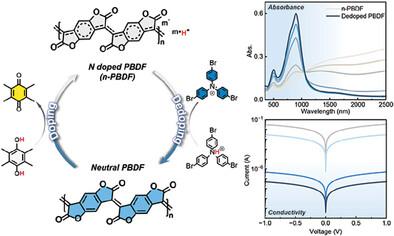当前位置:
X-MOL 学术
›
Adv. Funct. Mater.
›
论文详情
Our official English website, www.x-mol.net, welcomes your feedback! (Note: you will need to create a separate account there.)
Controlled Dedoping and Redoping of N‐Doped Poly(benzodifurandione) (n‐PBDF)
Advanced Functional Materials ( IF 19.0 ) Pub Date : 2024-04-15 , DOI: 10.1002/adfm.202400255 Zhifan Ke 1 , Jagrity Chaudhary 1 , Lucas Q. Flagg 2 , Kyle N. Baustert 3 , Augustine O. Yusuf 3 , Guangchao Liu 1 , Liyan You 1 , Kenneth R. Graham 3 , Dean M. DeLongchamp 2 , Jianguo Mei 1
Advanced Functional Materials ( IF 19.0 ) Pub Date : 2024-04-15 , DOI: 10.1002/adfm.202400255 Zhifan Ke 1 , Jagrity Chaudhary 1 , Lucas Q. Flagg 2 , Kyle N. Baustert 3 , Augustine O. Yusuf 3 , Guangchao Liu 1 , Liyan You 1 , Kenneth R. Graham 3 , Dean M. DeLongchamp 2 , Jianguo Mei 1
Affiliation

|
The doping levels of conjugated polymers significantly influence their conductivity, energetics, and optical properties. Recently, a highly conductive n‐doped polymer called poly (3,7‐dihydrobenzo[1,2‐b:4,5‐b′]difuran‐2,6‐dione) (poly(benzodifurandione), n‐PBDF) is discovered, opening new possibilities for n‐type conducting polymers in printed electronics and other fields. Controlling the doping level of n‐PBDF is of great interest due to its wide range of potential applications. Here controlled dedoping and redoping of n‐PBDF is reported and a mechanistic understating of such a process is provided. Dedoping occurs through electron transfer and proton capture, wherein the ionic dopants, tris(4‐bromophenyl)ammoniumyl hexachloroantimonate (Magic Blue), exhibit efficient proton capture ability and stronger interaction with n‐PBDF, resulting in high dedoping efficiency. Moreover, chemically dedoped PBDF can be redoped using various proton‐coupled electron transfer agents. By manipulating the doping levels of n‐PBDF thin films, ranging from highly doped to dedoped states, the system demonstrates controllable conductivity in five orders of magnitude, adjustable optical properties, and energetics. As a result, these characteristics demonstrate the potential applications of n‐PBDF in organic electrochemical transistors and thermoelectrics.
中文翻译:

N-掺杂聚苯并二呋喃二酮 (n-PBDF) 的受控去掺杂和再掺杂
共轭聚合物的掺杂水平显着影响其电导率、能量学和光学性质。最近,一种称为聚(3,7-二氢苯并[1,2-b:4,5-b']二呋喃-2,6-二酮)(聚(苯并二呋喃二酮),n-PBDF)的高导电n型掺杂聚合物的发现,为 n 型导电聚合物在印刷电子和其他领域开辟了新的可能性。由于其广泛的潜在应用,控制 n-PBDF 的掺杂水平引起了人们的极大兴趣。本文报道了 n-PBDF 的受控去掺杂和重掺杂,并提供了对该过程的机械理解。去掺杂通过电子转移和质子捕获发生,其中离子掺杂剂三(4-溴苯基)六氯锑酸铵(幻蓝)表现出高效的质子捕获能力以及与n-PBDF更强的相互作用,从而实现高去掺杂效率。此外,化学去掺杂的 PBDF 可以使用各种质子耦合电子转移剂进行再掺杂。通过控制 n-PBDF 薄膜的掺杂水平(从高掺杂到去掺杂状态),该系统展示了五个数量级的可控电导率、可调节的光学特性和能量。因此,这些特性证明了 n-PBDF 在有机电化学晶体管和热电器件中的潜在应用。
更新日期:2024-04-15
中文翻译:

N-掺杂聚苯并二呋喃二酮 (n-PBDF) 的受控去掺杂和再掺杂
共轭聚合物的掺杂水平显着影响其电导率、能量学和光学性质。最近,一种称为聚(3,7-二氢苯并[1,2-b:4,5-b']二呋喃-2,6-二酮)(聚(苯并二呋喃二酮),n-PBDF)的高导电n型掺杂聚合物的发现,为 n 型导电聚合物在印刷电子和其他领域开辟了新的可能性。由于其广泛的潜在应用,控制 n-PBDF 的掺杂水平引起了人们的极大兴趣。本文报道了 n-PBDF 的受控去掺杂和重掺杂,并提供了对该过程的机械理解。去掺杂通过电子转移和质子捕获发生,其中离子掺杂剂三(4-溴苯基)六氯锑酸铵(幻蓝)表现出高效的质子捕获能力以及与n-PBDF更强的相互作用,从而实现高去掺杂效率。此外,化学去掺杂的 PBDF 可以使用各种质子耦合电子转移剂进行再掺杂。通过控制 n-PBDF 薄膜的掺杂水平(从高掺杂到去掺杂状态),该系统展示了五个数量级的可控电导率、可调节的光学特性和能量。因此,这些特性证明了 n-PBDF 在有机电化学晶体管和热电器件中的潜在应用。



























 京公网安备 11010802027423号
京公网安备 11010802027423号